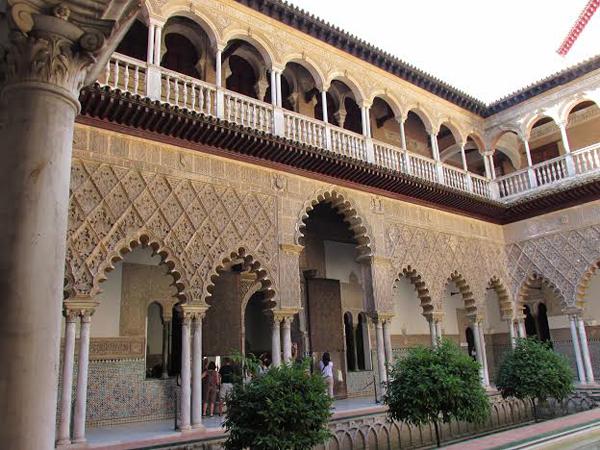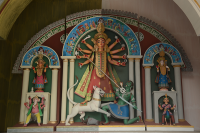 Image
Image
Perfect blending
Mudejar art of architecture and embellishments in Spain offers a glimpse into a time when Christian and Islamic art fused and created beauty together, discovers Ranjita Biswas
Art knows no bounds. An oft-repeated axiom is more than reflected in the Mudajar art of Spain, mainly witnessed in its southern part, the Andalusian region. It is a style of architecture and craftsmanship that have fused Christian art sensibilities , call it European if you like, and Islamic art. In these times when in many pockets of the world intolerance and refusal to recognize diversity are escalating, a look back in history of art development, like Mudejar, is perhaps not overdue..jpg)
If you are from the subcontinent and while visiting this corner of Europe, you could well be struck by a sense of familiarity as you encounter the architectural styles and decorations in many palaces, even churches, and in the well laid out gardens because they remind of those many back home highly influenced by Islamic art under the Mughals.
Far away in Spain, the influence of Islamic art can be traced to its medieval history. The Moors from Morocco conquered the Iberian peninsula i.e. Spain and Portugal, step by step beginning in early 8th century and reigned there for almost seven hundred years. Some dynasties were tolerant, allowing Christians and Jews to practice their faith as in Seville and Toledo, and the constructions even in synagogues showed Islamic style embellishments.
The Reconquista- reconquest of the so-called Christian lands by the Catholic kings and supported by the papacy began sometime in the mid 12th century and continued for another two hundred years or so. Moor citadels fell one by one; the last great city to fall was Granada. But the remnants of such a long rule remained, if not among the ruling class, in the cultural motifs.
.jpg) In Seville, for example, the great cathedral was built where the huge Almohad mosque existed and where people of other faiths congregated too in the wide courtyard from time to time. Today, the minaret- Giralda, el giraldillo so called by the local people because of the weathervane atop the bell tower, is all that remains of the Muslim legacy. With its beautiful brick panels it is regarded as one of the finest examples of Almohad dynasty architecture. The minaret was used by the muezzin to call the faithful for prayer.
In Seville, for example, the great cathedral was built where the huge Almohad mosque existed and where people of other faiths congregated too in the wide courtyard from time to time. Today, the minaret- Giralda, el giraldillo so called by the local people because of the weathervane atop the bell tower, is all that remains of the Muslim legacy. With its beautiful brick panels it is regarded as one of the finest examples of Almohad dynasty architecture. The minaret was used by the muezzin to call the faithful for prayer.
Nearby, the Alcazar (palace) is an astounding example of the fusion of Christian and Islamic architectural art in Mudejar style. Many Muslims stayed behind after the Christian reconquest , some even converted (Moriscos) and they were often hired by the new lords to decorate their homes. The evidence is there to see- in the brick work, plaster coatings, wooden ceilings, glazed tiles, and inlay furniture.
Mudejar art of decoration lays special emphasis on the techo artesonado, or ornately decorated coffered wooden ceiling. The spaces within the beams were covered with wood carvings, using geometric designs and plant motifs, or calligraphy. One of the finest examples, experts say, is this palace in Seville.
The Alcazar’s trelliswork, the blue tiles, the fountains in the patio reflect a time of co-existence too. King Peter I was a friend of the still ruling Muslim emir of Granada of the Nasrid dynasty. He sent some of his top artisans from his Alhambra palace to work on Peter’s palace..jpg)
The amazing Alhambra palace of Granada, a Unesco heritage site like the Seville Alcazar, has some of the finest Mudejar art ceilings and panels. The sunken gardens, hamams, the Lion square in the inner court, are more Muslim than Christian style in architecture. The Catholic kings, even after conquest, valued them and did not destroy. Today it offers an apt introduction to medieval art in the Iberian peninsula.
Segovia is another place, an old Spanish centre of power 91 km from Madrid, where the Alcazar shows off a richly embellished coffered ceiling in Mudejar style. The ceiling in the Pinecone room displays 1392 pine cones, each different from each other. Well-maintained, the golden ‘carpet’ of pinecones up above would surely dazzle your eyes.
Even in the north, Zaragoza has in its beautiful Aljafería palace many samples of Islamic art and Mudejar panels and ceilings.
Toledo, old capital of Spain, is a great centre of Mudejar art too. Its two synagogues, Santa Maria la Blanca (13th century) and the Transito synagogue (14th century) are in Gothic-Mudejar style where Christian and Arab heritage are merged with its Jewish heritage in a perfect jugalbandi.
(Photo by author)
Top Headlines
-
Art and Culture
Beyond Old and New: Bickram Ghosh and the Art of Fusion at Serendipity
December 25, 2025
-
Art and Culture
Saptak Music School of Pittsburgh hosts spellbinding evening of Indian classical music
September 23, 2025
-
Art and Culture
Zigzag to clarity: Sonal Mansinghs dance of life captivates Delhi
September 08, 2025
-
Art and Culture
USA: Santoor Ashram Kolkata mesmerises Los Angeles with a celebration of Indian classical music
August 27, 2025
-
Art and Culture
'Feels like a tonic in my musical pursuits': Flute virtuoso Pandit Ronu Majumdar receives Padma Shri
June 06, 2025
-
Art and Culture
Of Paris, a chronic pain and a pivotal friendship: Frida Kahlo meets Mary Reynolds at the Art Institute of Chicago
April 16, 2025
-
Art and Culture
Prabha Khaitan Foundation celebrates 'Vasant Utsav' at Indian Museum Kolkata
March 15, 2025
-
Art and Culture
Musical concert 'Ami Bhalobashi Bangla Ke' to be held in Kolkata on April 19
February 20, 2025
-
Art and Culture
A kiss in front of The Kiss? Vienna museum's V-Day offer is ode to Klimt's artistic masterpiece
February 10, 2025
-
Art and Culture
Dalhousie Square: Timekeeping with Kolkata's British gems
January 12, 2025

